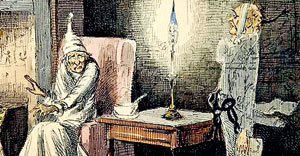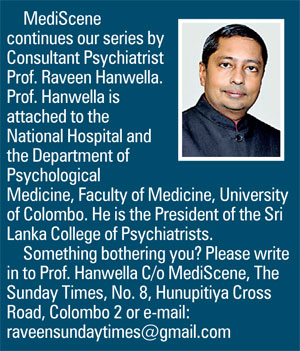Can we humans really change like Scrooge?
View(s):By Prof. Raveen Hanwella
I have endeavoured in this Ghostly little book, to raise the Ghost of an Idea, which shall not put my readers out of humour with themselves, with each other, with the season, or with me. May it haunt their houses pleasantly, and no one wish to lay it.
Charles Dickens – A Christmas Carol
 It is Christmas time again. Time again to re-read my favourite book, A Christmas Carol by Charles Dickens. Since he wrote it in 1843 it has sold millions of copies worldwide and has been continuously in print for the last 170 years. This heart-warming story of repentance, redemption and transformation has become synonymous with the holiday season.
It is Christmas time again. Time again to re-read my favourite book, A Christmas Carol by Charles Dickens. Since he wrote it in 1843 it has sold millions of copies worldwide and has been continuously in print for the last 170 years. This heart-warming story of repentance, redemption and transformation has become synonymous with the holiday season.
In the book, a rich but miserly individual named Scrooge, after being haunted by three Ghosts, is transformed into a kind and generous individual. Apart from being a wonderful piece of literature, the fascination for me as a psychiatrist, is the total change of a personality almost overnight. But this is fiction. Is it really possible for people to make radical changes to their lives, shed bad habits, transform narrow perspectives to broader views, and become more forgiving and charitable towards their fellow human beings?
Can human beings really change? Can the human brain change after we become adults? When I was in medical school many years ago, we were taught that the human brain cannot grow new cells after the first two years of life, and that if our brain cells die we can never regenerate that part. Now we know that this is not true. We know that the brain can grow new cells, grow new connections and develop new patterns of thinking. This ability of the brain is called neuroplasticity. It is a term, meaning that the brain is plastic or malleable and can remodel in response to experience.
Your brain is made up of around 100 billion cells or neurons each making upto 10,000 connections, or synapses with other neurons. Neurons communicate with each other by sending chemical signals across synapses. These signals are not random but organised into patterns. These patterns literally is our mind and determines our thoughts, impulses, habits and abilities.
 The term neuroplasticity was coined by neurologist, Paul Bach-y-Rita. In 1958 his father, Pedro suffered a serious stroke which left him paralysed on one side of his body and unable to speak. It was thought that he would never speak or walk again. Neurologists those days believed that brain damage was permanent. If a stroke caused paralysis or other loss of function for more than a few months it was considered irreversible.
The term neuroplasticity was coined by neurologist, Paul Bach-y-Rita. In 1958 his father, Pedro suffered a serious stroke which left him paralysed on one side of his body and unable to speak. It was thought that he would never speak or walk again. Neurologists those days believed that brain damage was permanent. If a stroke caused paralysis or other loss of function for more than a few months it was considered irreversible.
Paul’s brother, George who was a medical student at the time (he became a well-known psychiatrist) took on the challenge of rehabilitating his father. After three years of effort Pedro recovered almost completely and went back to his job as a teacher. For five more years he led an active life and died at 73 of a heart attack while hiking in the Colombian mountains. The real surprise came when Pedro’s brain was examined after his death. There was severe damage to his brain and major parts were atrophied. Yet the brain had reorganised itself and enabled Pedro to function normally. This experience changed Paul’s life and he went on to become the Professor of Rehabilitation Medicine in the University of Wisconsin. Later he was awarded the Coulter Award from the American Congress of Rehabilitation Medicine in recognition of his contributions to the field of neuro rehabilitation.
In a TED talk in June 2016, Dr Lara Boyd, a neuroscientist, explained how neuroplasticity works (you can Google it and watch it for yourself). The brain can change in three different ways. The first is chemical. I explained earlier that neurons communicate with each other through chemical signals. This kind of change can happen quickly and helps in remembering things for a short time or improves a motor skill briefly. The second is more permanent and the brain alters its structure by changing the connections between its neurons. These changes support long term memory and more enduring improvement in motor skills.
Take the example of trying to learn a musical instrument. After a few days practice you feel you are better at it. Perhaps you then take a break and return a week later and are disappointed to find that you have lost all the gains. How do we explain it? In the short term the brain was able to improve functioning by increasing the strength of the chemical signals. But this does not translate to structural changes. With continued practice these structural changes do take place and result in permanent change. This explains why novice chess players will soon lose their skills without practice whereas a grandmaster will perform at a high level even years after a period of inactivity. The skills are hard wired into the grandmaster’s brain.
What happens if you lose a part of your brain either through accident or disease as happened to Paul’s father? This is the third way in which the brains change. Over time different parts of our brain become specialised for certain activities. For example there are parts of the brain that control our speech, hearing and vision. Damage to these areas will result in loss of that function. But the brain is capable of transferring that function to a different part of the brain. This explains what happened in the case of Pedro. Even though large parts were damaged, through intensive training his brain was able transfer those functions to another intact area resulting in his almost miraculous recovery.
There is a negative side to neuroplasticity as well. As much as positive action can result in brain cell growth, negative thoughts, actions and mood states can actually kill brain cells. It has been demonstrated in rats and monkeys (it is not possible to do this experiment in living human beings at this moment in time) that when stressed, neurons in certain parts of the brain die and when given an electric shock (it is used as a therapy in the treatment of depression) the cells grow back.
Remember uncharitable angry thoughts can kill your brain cells, and happy, forgiving and productive thoughts will make your brain cells grow and network to form useful lifelong skills, thoughts and moods. Isn’t that a thought worth keeping?
A Happy Christmas and New Year to all my readers !


